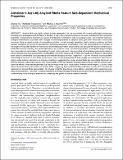| dc.contributor.author | Xu, Zhiping | |
| dc.contributor.author | Paparcone, Raffaella | |
| dc.contributor.author | Xu, Shiping | |
| dc.contributor.author | Buehler, Markus J | |
| dc.date.accessioned | 2015-03-17T20:24:40Z | |
| dc.date.available | 2015-03-17T20:24:40Z | |
| dc.date.issued | 2010-05 | |
| dc.date.submitted | 2009-11 | |
| dc.identifier.issn | 00063495 | |
| dc.identifier.issn | 1542-0086 | |
| dc.identifier.uri | http://hdl.handle.net/1721.1/96060 | |
| dc.description.abstract | Amyloid fibrils are highly ordered protein aggregates that are associated with several pathological processes, including prion propagation and Alzheimer's disease. A key issue in amyloid science is the need to understand the mechanical properties of amyloid fibrils and fibers to quantify biomechanical interactions with surrounding tissues, and to identify mechanobiological mechanisms associated with changes of material properties as amyloid fibrils grow from nanoscale to microscale structures. Here we report a series of computational studies in which atomistic simulation, elastic network modeling, and finite element simulation are utilized to elucidate the mechanical properties of Alzheimer's Aβ(1-40) amyloid fibrils as a function of the length of the protein filament for both twofold and threefold symmetric amyloid fibrils. We calculate the elastic constants associated with torsional, bending, and tensile deformation as a function of the size of the amyloid fibril, covering fibril lengths ranging from nanometers to micrometers. The resulting Young's moduli are found to be consistent with available experimental measurements obtained from long amyloid fibrils, and predicted to be in the range of 20–31 GPa. Our results show that Aβ(1-40) amyloid fibrils feature a remarkable structural stability and mechanical rigidity for fibrils longer than ≈100 nm. However, local instabilities that emerge at the ends of short fibrils (on the order of tens of nanometers) reduce their stability and contribute to their disassociation under extreme mechanical or chemical conditions, suggesting that longer amyloid fibrils are more stable. Moreover, we find that amyloids with lengths shorter than the periodicity of their helical pitch, typically between 90 and 130 nm, feature significant size effects of their bending stiffness due the anisotropy in the fibril's cross section. At even smaller lengths (⪅50 nm), shear effects dominate lateral deformation of amyloid fibrils, suggesting that simple Euler-Bernoulli beam models fail to describe the mechanics of amyloid fibrils appropriately. Our studies reveal the importance of size effects in elucidating the mechanical properties of amyloid fibrils. This issue is of great importance for comparing experimental and simulation results, and gaining a general understanding of the biological mechanisms underlying the growth of ectopic amyloid materials. | en_US |
| dc.description.sponsorship | United States. Office of Naval Research | en_US |
| dc.description.sponsorship | United States. Defense Advanced Research Projects Agency | en_US |
| dc.description.sponsorship | MIT Energy Initiative | en_US |
| dc.description.sponsorship | National Science Foundation (U.S.) | en_US |
| dc.language.iso | en_US | |
| dc.publisher | Elsevier | en_US |
| dc.relation.isversionof | http://dx.doi.org/10.1016/j.bpj.2009.12.4317 | en_US |
| dc.rights | Article is made available in accordance with the publisher's policy and may be subject to US copyright law. Please refer to the publisher's site for terms of use. | en_US |
| dc.source | Elsevier | en_US |
| dc.title | Alzheimer's Aβ(1-40) Amyloid Fibrils Feature Size-Dependent Mechanical Properties | en_US |
| dc.type | Article | en_US |
| dc.identifier.citation | Xu, Zhiping, Raffaella Paparcone, and Markus J. Buehler. “Alzheimer’s Aβ(1-40) Amyloid Fibrils Feature Size-Dependent Mechanical Properties.” Biophysical Journal 98, no. 10 (May 2010): 2053–2062. © 2010 Biophysical Society. | en_US |
| dc.contributor.department | Massachusetts Institute of Technology. Center for Computational Engineering | en_US |
| dc.contributor.department | Massachusetts Institute of Technology. Department of Civil and Environmental Engineering | en_US |
| dc.contributor.department | Massachusetts Institute of Technology. Department of Materials Science and Engineering | en_US |
| dc.contributor.department | Massachusetts Institute of Technology. Laboratory for Atomistic and Molecular Mechanics | en_US |
| dc.contributor.mitauthor | Xu, Shiping | en_US |
| dc.contributor.mitauthor | Buehler, Markus J. | en_US |
| dc.contributor.mitauthor | Paparcone, Raffaella | en_US |
| dc.relation.journal | Biophysical Journal | en_US |
| dc.eprint.version | Final published version | en_US |
| dc.type.uri | http://purl.org/eprint/type/JournalArticle | en_US |
| eprint.status | http://purl.org/eprint/status/PeerReviewed | en_US |
| dspace.orderedauthors | Xu, Zhiping; Paparcone, Raffaella; Buehler, Markus J. | en_US |
| dc.identifier.orcid | https://orcid.org/0000-0002-4173-9659 | |
| mit.license | PUBLISHER_POLICY | en_US |
| mit.metadata.status | Complete | |
